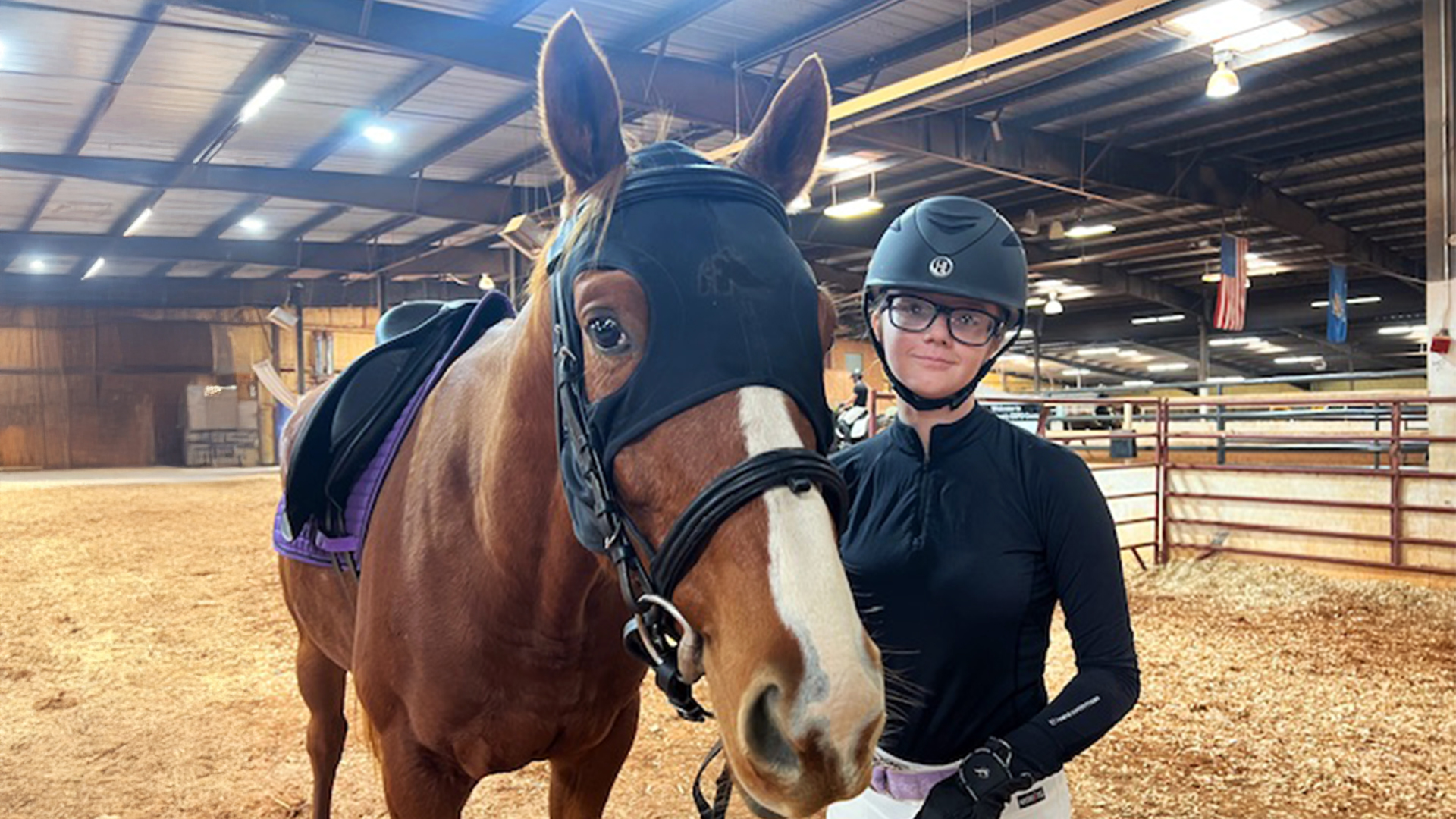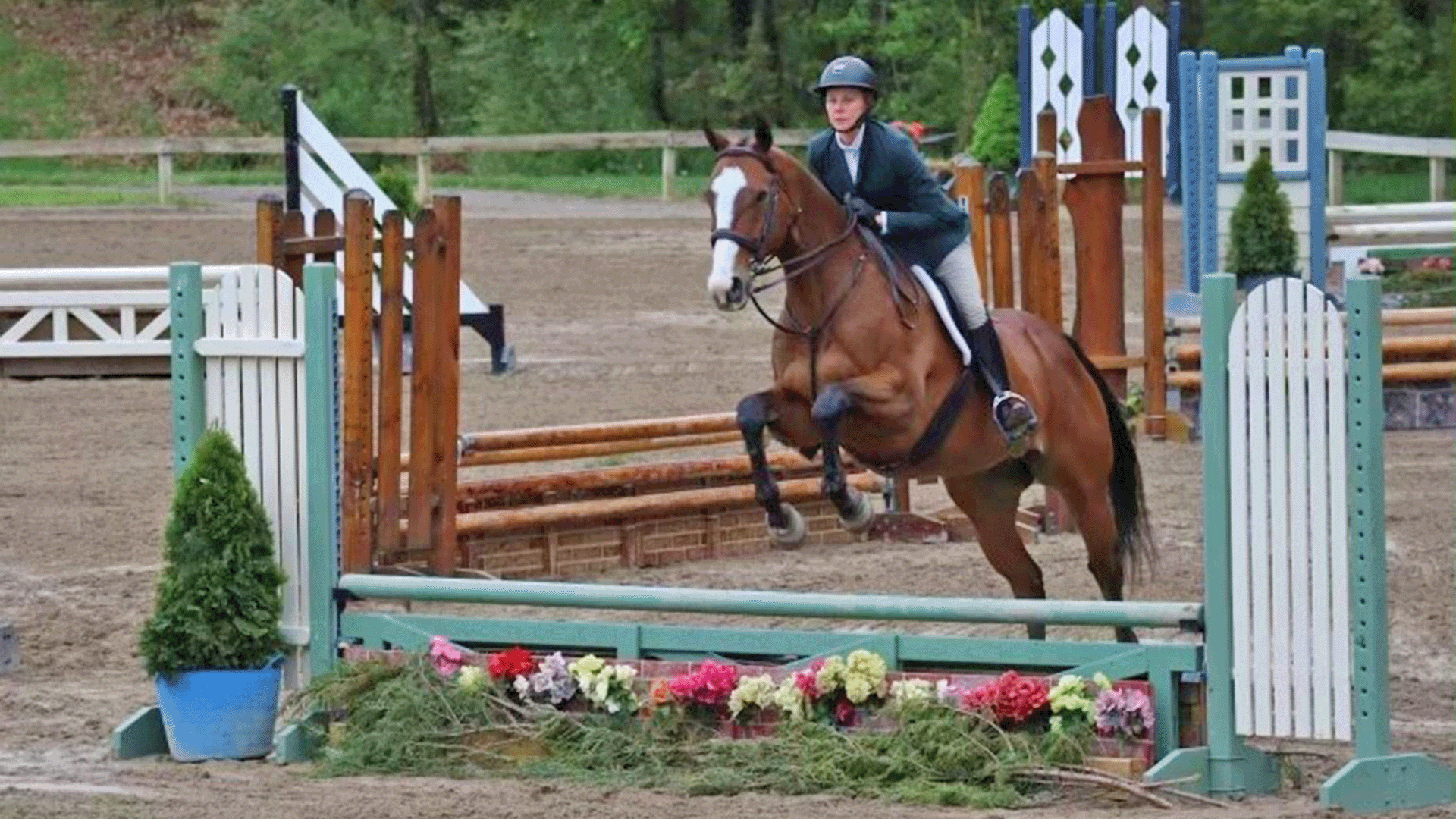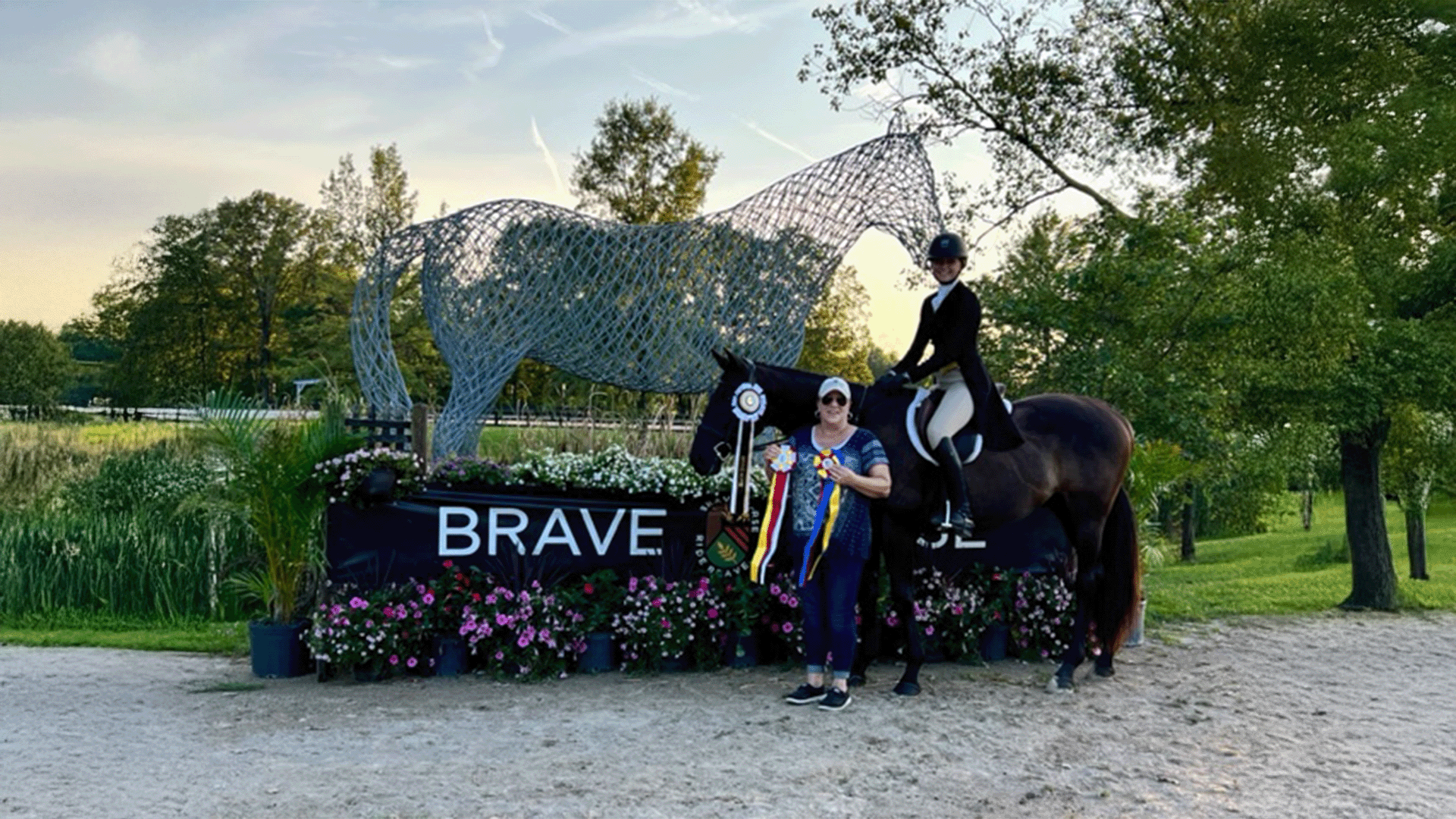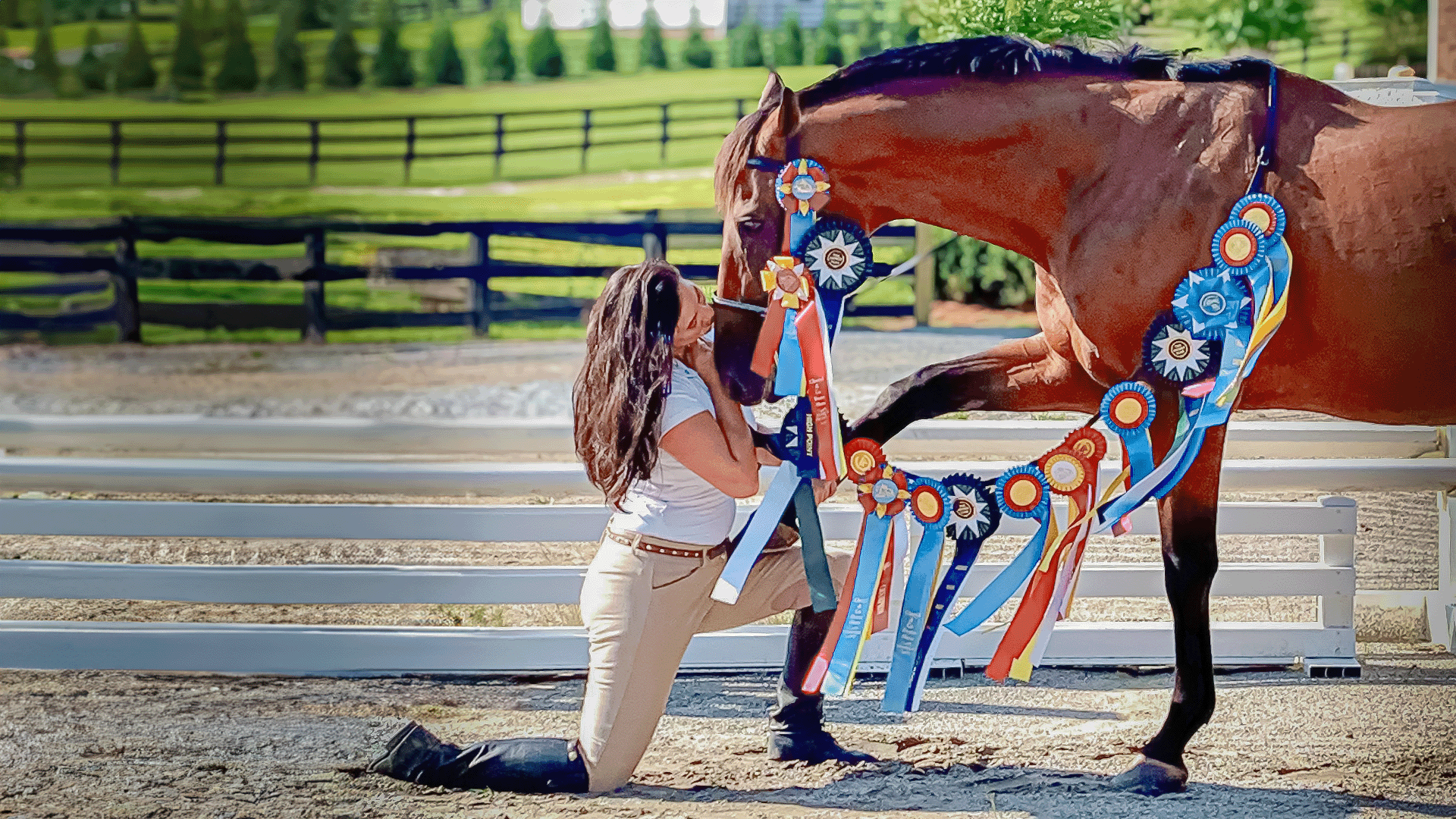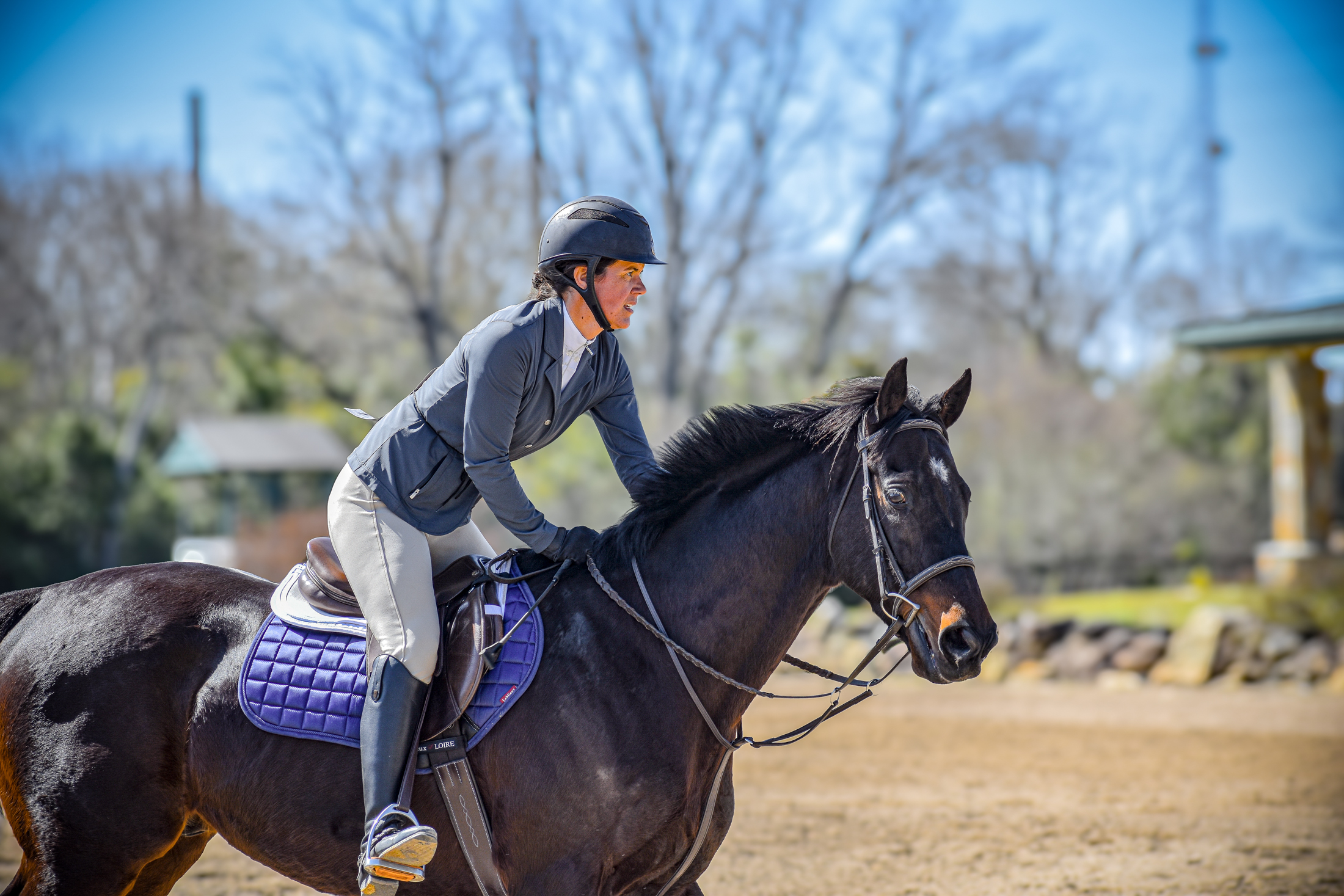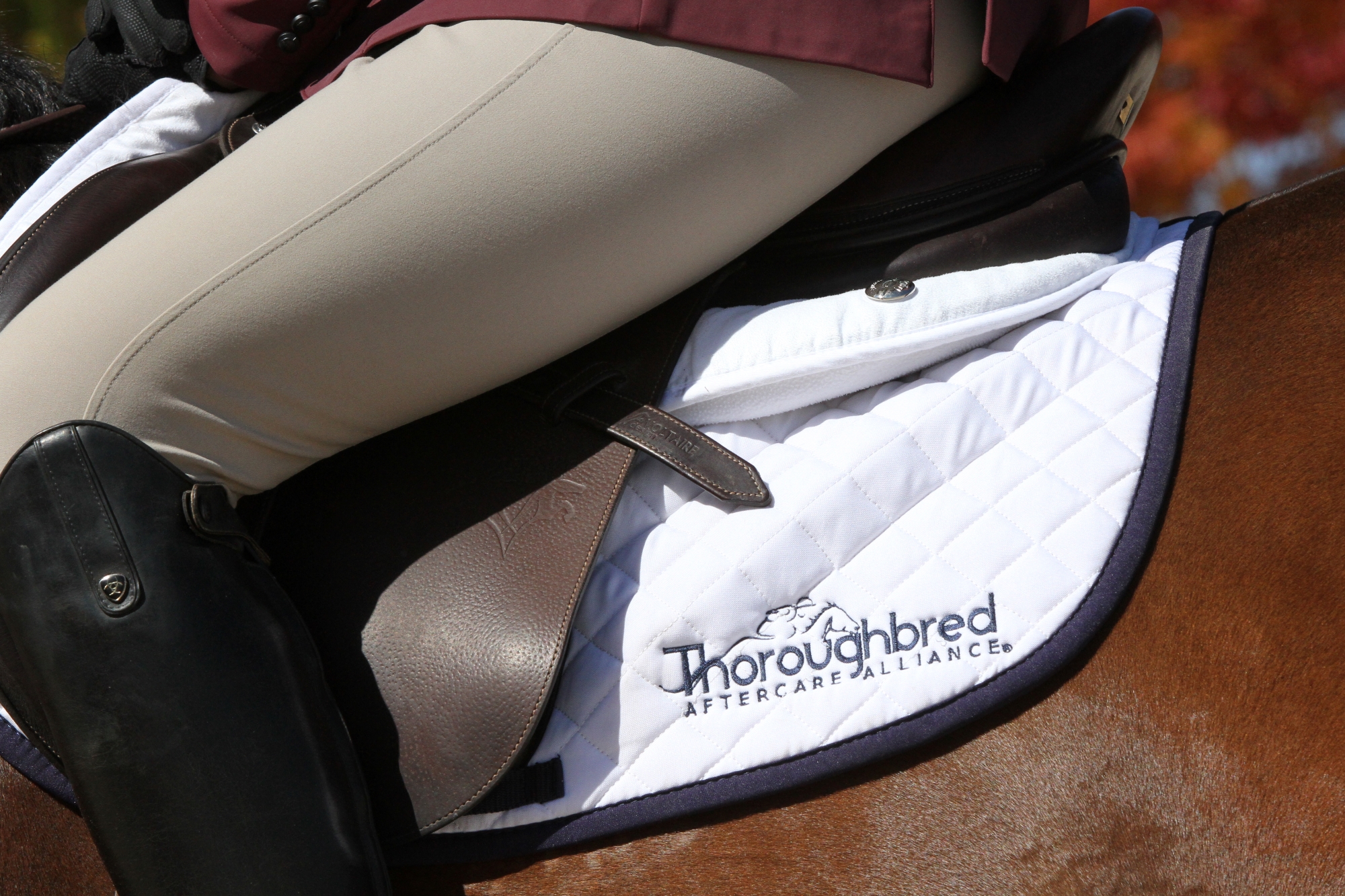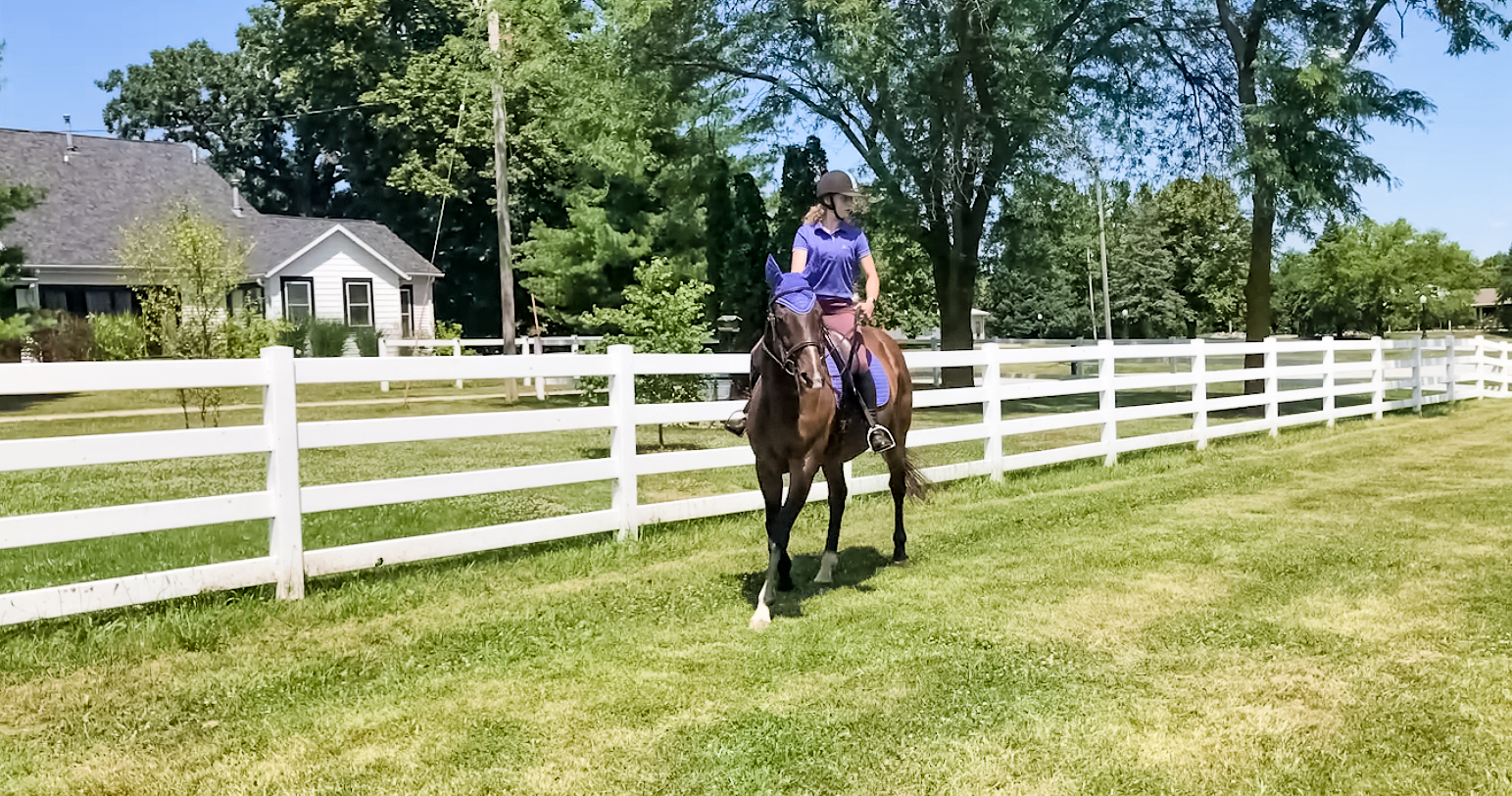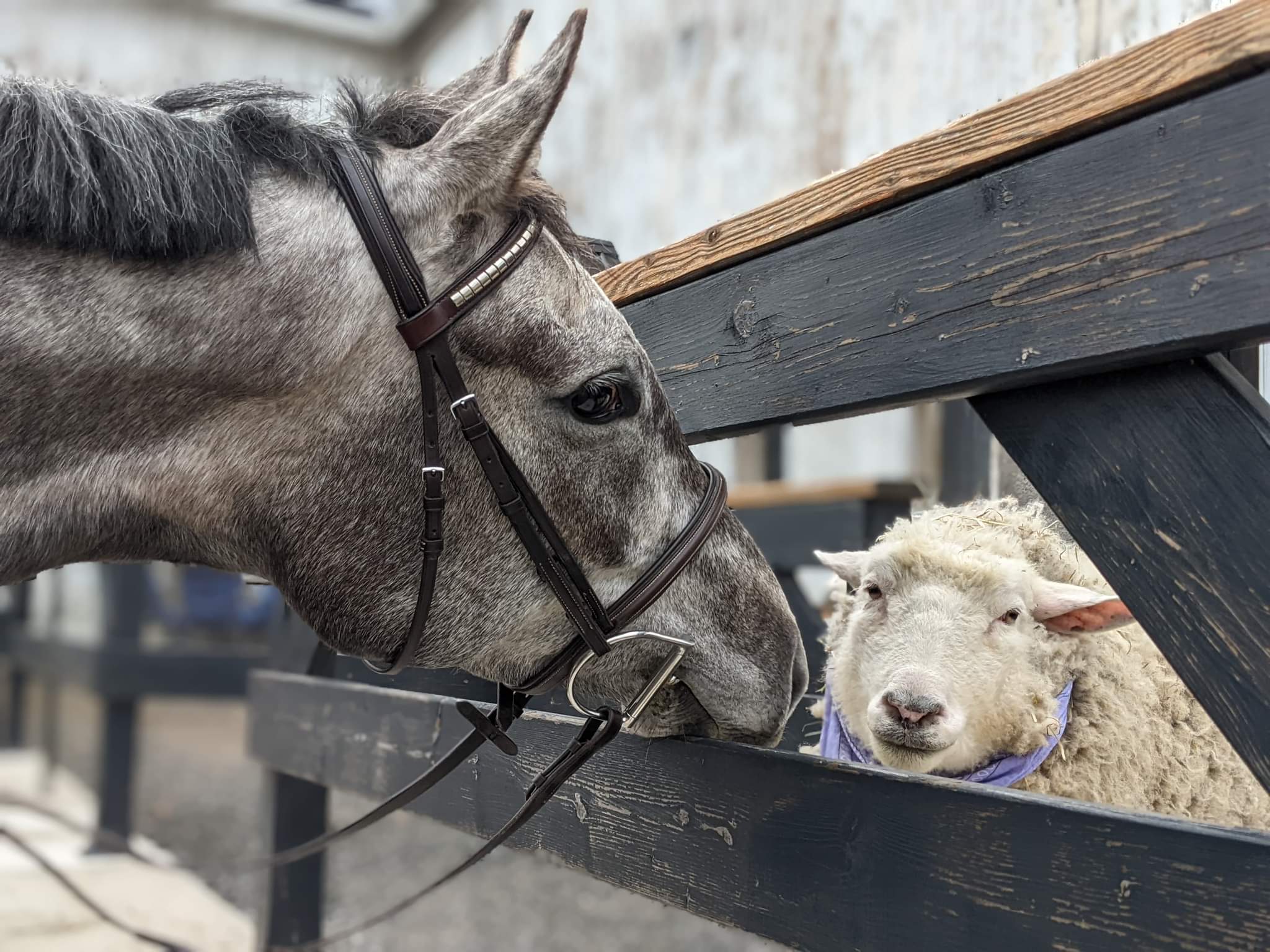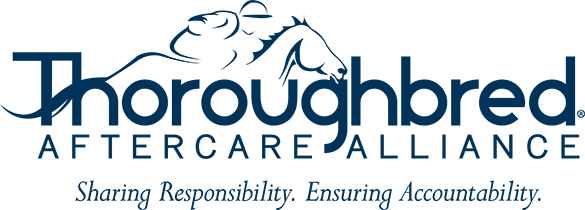hunter jumper
All Posts & News Press Releases Success Stories Aftercare Editorials Retraining Tips Supporter Features Equine-Assisted Learning Inspector Spotlights Hamburger Toggle Menu Previous Post Headlights On, Future Bright Headlights On, Future Bright By: Alexis Arbaugh April 14, 2025 Success Stories Tags:accredited aftercare, Accredited Organization, dressage, Horse and Hound Rescue Foundation, hunter jumper, Thoroughbred Aftercare Alliance, Thoroughbred Athletes, United States Pony Clubs, USPC Headlights On, a chestnut gelding born in April 2019, never raced but found a new purpose through the Horse and Hound Rescue Foundation, where he arrived in September 2022. Bridgett Nicole and her family had been browsing the Horse and Hound Rescue Foundation website for several months when her youngest daughter, Aspyn, expressed a serious interest in adopting a horse of her own. Aspyn’s older sister, Erin, already owned an off-the-track Thoroughbred, so Aspyn knew she wanted a Thoroughbred as well. Erin had adopted Red Road Okie, now known as Dexxter, from Thoroughbred Athletes in 2013. Both Horse and Hound Rescue Foundation and Thoroughbred Athletes are accredited through Thoroughbred Aftercare Alliance. Their missions are centered on rehabilitating and retraining off-the-track Thoroughbreds in the hope of successful rehoming. Aspyn led the search herself, browsing available horses until she felt ready to take the next step. One name stood out to everyone: Headlights On. While color wasn’t a dealbreaker, his chestnut coat was a definite bonus in her eyes. After narrowing down the options, Bridgett sent Aspyn’s list to Nelda Kettles, executive director of Horse and Hound. Fortunately, Nelda felt Headlights On would be a perfect fit. When the family met him in person, Aspyn fell instantly in love. Now affectionately called Arashi, the Japanese word for “storm”, the gelding has adjusted to his new life with ease. After his arrival at Horse and Hound in 2022, he was restarted under saddle by Jamie Jennings of Fly Over Farm, who helped prepare him for a second career. “Arashi’s personality is very much ‘supervisor-like.’ He’s got to be involved in everything,” Bridgett said. Arashi is extremely intelligent, and stubborn, according to Aspyn. “He’s not fond of Dressage—it’s all intro level at this point. Circles are boring to him. But put a cross rail in front of him, and he’s happy.” Currently, Aspyn and Arashi are training for the hunter ring with Sam Powell of Paradigm Farm. They also practice lower-level Dressage on their own. “He takes care of Aspyn, and Aspyn takes care of him,” Bridgett shared. Aspyn recently founded a brand-new Pony Club team in Norman, Oklahoma. With her own horse and her own team, she now dreams of competing at the Pony Club Championships in Kentucky and hopes to attend a few rated shows. Share This Article Do you have a success story that you would like to share? Submit your experience with an accredited organization here: Success Story Submission
Read More >All Posts & News Press Releases Success Stories Aftercare Editorials Retraining Tips Supporter Features Inspector Spotlights Humberger Toggle Menu Previous Post Turn Towards Home Turn Towards Home By: Alexis Arbaugh September 27, 2024 Success Stories Tags:accredited aftercare, CANTER, CANTER Michigan, hunter jumper, Thoroughbred Aftercare Alliance Turner was brought to CANTER Michigan in December 2021, and about four months later, Jen adopted him as a potential project horse for a friend. “I was struck by how gorgeous and sweet he was,” she recalls. It was love at first sight. Fortunately for Jen, as Willowbrooke’s barn manager, Turner could stay on the farm after his adoption. Before adopting Turner, Jen knew he had been diagnosed with kissing spine—a condition where the vertebrae are too close or overlap, causing discomfort or pain. Despite the diagnosis, she took a chance, aware that it would require regular maintenance. At the time of his adoption, Turner stood at a lanky 16.2 hands. Thanks to good care and training, he is now a muscular 17.1 hands and shows no signs of pain. “He truly enjoys working, especially jumping,” Jen says. Although Jen doesn’t ride Turner herself, she plays an active role in his training. Initially, it was challenging. Turner received only minimal retraining at CANTER, so Jen and her friend had significant work ahead. “He was afraid of everything—from noises outside the ring to traffic in the ring, to even the sound of a horse simply picking up the canter,” Jen explains. Turner’s fear-driven response was to bolt, a daunting reaction for such a large horse. “The moment I first saw him, I fell in love,” says Jen Murdoch, barn manager of Willowbrooke Farm, a CANTER Michigan facility. CANTER Michigan (Communication Alliance to Network Thoroughbred Ex-Racehorses) has been transitioning racehorses into second careers since 1998. Turnagain Tide, affectionately known as “Turner,” was one of the lucky horses taken in by the program. A 2017 Kentucky-bred dark bay Thoroughbred gelding, Turner was sold at the 2018 Keeneland September yearling sale for $750,000. Both Taylor Made Sales and Keeneland Sales are active supporters of Thoroughbred Aftercare Alliance. His impressive lineage includes sire Into Mischief, North America’s leading sire from 2019-2023. He raced five times, winning twice and earning $73,639 under trainer Brad Cox before retiring. The experience was enlightening for his team, who discovered that Turner benefits from a morning ride to calm his nerves before competing. His success has earned him a range of year-end awards from HJAM, including champion titles in Low Adult Hunter, Low Adult Equitation, and Low Adult Medal. He will also place fifth in the Baby Green Hunters and sixth in Low Adult Equitation on the Flat. Turner’s future looks bright. Jen hopes to see him progress to the 3′ divisions and eventually qualify for the Take2 Thoroughbred Hunter Finals at the Kentucky National Horse Show. The key to Turner’s progress was patience. Jen and her riders worked carefully to avoid heightening his anxiety. “Through the patience and persistence of his riders, he is now much more confident, and the behavior is essentially gone,” she notes. His transformation has been remarkable. With newfound confidence, Turner excelled in his training, becoming a fantastic jumper. The shift extended beyond the ring—he’s now curious and enjoys exploring his surroundings, a stark contrast to his earlier spookiness. To ease him into the show world, Turner participated in several schooling shows at Willowbrooke Farm, quickly progressing to higher levels of competition. In August 2023, he made his debut at The World Equestrian Center, competing for two weeks in the 2’6″ divisions. Turner shined, taking champion in the Low Adult Equitation and reserve champion in the Low Adult Hunter during the first week. He repeated the success in week two, claiming champion in the Low Adult Hunter and reserve champion in Low Adult Equitation. Turner also won the Hunter Jumper Association of Michigan (HJAM) Low Adult Medal Final. Share This Article Do you have a success story that you would like to share? Submit your experience with an accredited organization here: Success Story Submission
Read More >All Posts & News Press Releases Success Stories Aftercare Editorials Retraining Tips Supporter Features Inspector Spotlights Humberger Toggle Menu Previous Post manhattan striker Manhattan Striker By: Alexis Arbaugh September 27, 2024 Success Stories Tags:accredited aftercare, CANTER, CANTER Michigan, Eventing, hunter jumper, Retired Racehorse Project, RRP TIP, TAKE2, Thoroughbred Aftercare Alliance, Thoroughbred Incentive Program “This has been a life-changing experience for my daughter and has shaped her in more ways beyond just in the saddle,” shared Sara Anderson. Sara Anderson and her 11-year-old daughter, Anna Huard, were searching for a horse that could become a long-term equine partner and compete in the 2018 Retired Racehorse Project (RRP). They turned to CANTER Michigan because it offered potential adopters the chance to meet and ride horses before adoption. Upon their visit, they were introduced to Manhattan Striker by CANTER Michigan’s head trainer, Jennifer Blades. Manhattan Striker, an Australian-bred black Thoroughbred gelding, had raced 23 times and earned $39,750 in Hong Kong. After his racing career ended, he was part of a group of 12 horses donated to CANTER Michigan. When Sara and Anna first met Manhattan Striker, he wasn’t the warm and affectionate horse he is today. His paperwork from the track noted that he cribbed, stall-walked, and had a generally grumpy attitude. The barn staff at Willowbrooke Farm, the facility where he was housed, had to be cautious when handling him. Despite these quirks, Sara described him as having a “serious and quiet demeanor,” which soon proved to be a great match for Anna’s personality. Manhattan Striker quickly bonded with Anna, taking an immediate liking to her. Sara observed that he seemed solid and balanced under saddle, and Anna saw potential for a long-term partnership. Although he remained grumpy during grooming, once he came home, he stopped cribbing and stall-walking altogether. He soon became sweet and affectionate with Anna and the other children at the barn. His temperament mellowed so much that he even became a suitable turnout companion for weanlings. Anna had ambitious goals for herself and Manhattan Striker, affectionately known as “Manny.” She wanted a versatile partner she could train to compete in multiple disciplines and develop a close bond with. Manny exceeded her expectations. “The retraining process was interesting,” Sara recalled. Manny wasn’t overly hot and adapted quickly to everything he was asked to do. Their goal was to enter the 2018 RRP, and Sara allowed Anna to take the lead in his training. While Manny initially lacked a lead change, he mastered it after just one lesson. “He’s been great for my daughter because she’s been able to teach him things, and he responds and learns the way you hope they will,” Sara said. Manny always tries his best and doesn’t hold a grudge if Anna makes a mistake. Through their journey together, Anna learned the value of patience and building a solid foundation with her horse. At horse shows, Manny was a dream. “No AM lounge, no hard schooling. No trainer rides, no perfect prep or ear plugs. He doesn’t even wear a martingale to mess with. Goes in a simple rubber D. He doesn’t need to see the ring before going into a class. Light warmup, a few jumps, and in he goes,” Sara wrote. Manny was also easy to load and handle at shows, and Anna could braid and prep him herself. Screenshot Although Manny isn’t the best mover, making it tough to place in hack classes, he shines as a jumper. He thrives in equitation and medal classes, excelling at technical tracks, halts, and counter-cantering. “He’s able to take the harder courses and do all the fun things,” Sara said. Anna and Manny successfully competed in the Hunter division at the 2018 RRP. They continued training and later competed in local 2’6″ Hunter classes. For a change of pace, they also enjoyed eventing. In 2022 and 2023, the pair competed in the Take2 Thoroughbred divisions and the 15-17 equitation division with notable success. Anna and Manny were named the 2023 Overall Top Junior Rider in the Take2 Hunter division and placed 9th in the Take2 Finals. “We’re also thankful for Thoroughbred-specific opportunities like the RRP, Take2, and TIP, which give kids like mine a supportive community,” Sara wrote. Manny has surpassed all the goals Anna set for him, and they have formed a strong bond along the way. Looking ahead to 2024, they plan to continue competing in the Take2 Hunter divisions and enter more equitation and medal classes during Anna’s final junior year. This past July, Anna and Manny were selected to participate in the United States Hunter Jumper Association (USHJA) Emerging Athletes Program at St. Mary-of-the-Woods College in Indiana, where Manny stood out as the only Thoroughbred. Share This Article Do you have a success story that you would like to share? Submit your experience with an accredited organization here: Success Story Submission
Read More >All Posts & News Press Releases Success Stories Aftercare Editorials Retraining Tips Supporter Features Inspector Spotlights Humberger Toggle Menu Previous Post Moab’s Journey to the RRP Moab’s Journey to the RRP By: Alexis Arbaugh September 27, 2024 Retraining, Success Stories Tags:accredited aftercare, Godolphin, hunter jumper, Retired Racehorse Project, The Thoroughbred Makeover, Thoroughbred Aftercare, Thoroughbred Aftercare Alliance Moab was donated to The University of Findlay (UF) in the spring of 2023 by Godolphin, one of the world’s leading Thoroughbred breeding and racing operations. Godolphin, also a proud supporter of Thoroughbred Aftercare Alliance, is profoundly invested in the aftercare of Thoroughbreds. For years, Godolphin has supported UF’s breaking and retraining program by donating horses, highlighting their commitment to Thoroughbred aftercare. At the start of the fall semester, Ryanne, a junior in the English Equestrian Program, was assigned to work with Moab. In this program, students take full responsibility for a horse’s care and riding each semester. As they progress, students may be assigned multiple horses and are encouraged to break or retrain young horses after their freshman year. Moab, a 2020 bay gelding by Street Sense out of Skylighter, didn’t race but received some initial under-saddle training before arriving at UF. Ryanne felt relieved that she didn’t have to start from scratch, though retraining an ex-racehorse can still be challenging. Fortunately, this wasn’t Ryanne’s first experience working with a green or unbroken horse. During her sophomore year, she spent time at Findlay’s Western Farm, where she worked alongside students and trainers to break colts. Ryanne’s passion for horses began at age eight, starting with Hunter/Jumper lessons before progressing to dressage until she was 18. After high school, she enrolled at The University of Findlay and joined the English Equestrian Program, where she trained under the Hunter/Jumper coach. Most recently, Ryanne spent the summer in Wellborn, Florida, working with a variety of horses—broke, green, and unbroke—honing her skills with different levels of training. When Moab arrived at The University of Findlay, he was given time to settle into his new surroundings. By mid-August, his training with Ryanne began. Despite Moab’s calm demeanor on the ground, they approached the retraining process slowly and carefully. They worked in the detached indoor arena, where young and unbroke horses are started due to its quieter environment. Like all Findlay students, Ryanne began Moab’s training in the round pen to maintain better control. She started with lunging and eventually taught him how to line drive. Understanding the importance of forward motion in horse training, Ryanne focused on ensuring that Moab moved forward and responded to her aids, knowing that this would lay the foundation for further success. When Ryanne felt that Moab was ready to be ridden, she mounted him for the first time. Mounting can be tricky if the horse hasn’t been properly handled beforehand. To keep him calm, she had a classmate hold him while she mounted, helping Moab stay relaxed. Teaching him to stand still after mounting took time, but with patience, Moab eventually learned to wait for Ryanne’s cue to walk off. Now, mounting is easy and doesn’t faze either of them. After mounting, Ryanne’s priority was establishing forward movement and straightness. Encouraging forward motion helps the horse focus on “thinking forward” and paying attention to the rider’s aids. Straightness improves the horse’s balance and body awareness, helping them understand where all four legs are in relation to each other. These foundational elements are crucial for Moab’s training and overall responsiveness to Ryanne’s cues. While Moab’s under-saddle training progressed, Ryanne also focused on refining his ground manners. She introduced him to clippers and mane pulling, both of which he tolerated well, standing calmly during grooming sessions. They also worked on trailer loading, which he handled without any issues, further proving himself to be an all-around easy-going horse. Moab did have one quirky habit—he loved to put everything in his mouth. From blankets to Ryanne’s clothes, if it was within reach, Moab would try to chew on it. Like many young horses, this behavior stemmed from curiosity, as licking and chewing help them explore their surroundings. However, if left unchecked, it could lead to unwanted biting or nipping. Gradually, Moab began to learn that chewing on toys and treats was acceptable, but clothes—his or Ryanne’s—were off-limits. After achieving straightness, Ryanne focused on more advanced training, including teaching Moab to respond to bit pressure and use his body more efficiently. Moab excelled in these challenges, eagerly responding to Ryanne’s cues. Before long, he became strong enough to lift his back while being ridden and carry himself properly. He learned to bend and flex without losing balance, though it was more challenging for him at the trot and canter than at the walk. By taking things slow and steady, Moab was able to learn correctly, always showing a desire to do the right thing. At this stage, Ryanne recognized that Moab needed more mental stimulation. She decided to introduce ground poles as the next challenge in their preparation for the Retired Racehorse Project. Walking, trotting, and cantering over the poles didn’t bother Moab at all, so Ryanne began teaching him how to jump. Moab seemed to enjoy it, treating it like a fun game, so she continued raising the jumps and challenging him with more complex exercises and combinations. With the Retired Racehorse Project approaching, they worked diligently on lateral movements for the dressage test and perfected their 2’6″ fences for the show Hunter courses. Ryanne soon knew that Moab was ready to compete in The Retired Racehorse Project because his response time under saddle became quick and dependable. “There was no longer a conversation—I’d ask, and he’d respond with ‘yes ma’am,’” Ryanne wrote. Another sign of his readiness came when one of her classmates rode him, and Moab performed just as well for her as he did for Ryanne. It was clear that all the pieces of their training were falling into place, and Moab was fully prepared for the show. Competing at The Retired
Read More >All Posts & News Press Releases Success Stories Aftercare Editorials Retraining Tips Supporter Features Inspector Spotlights Humberger Toggle Menu Previous Post Taking a Leap of Faith Taking a Leap of Faith By: Alexis Arbaugh September 26, 2024 Success Stories Tags:Blue Bloods Thoroughbred Adoption and Placement, Georgia Hunter Jumper Association, hunter jumper, Success story, Thoroughbred Aftercare Allince, Thoroughbred Incentive Program, TIP Photo Credit: Joy Nakrin Joy Nakrin took a huge leap of faith when she adopted a horse sight unseen from Blue Bloods Thoroughbred Adoption and Placement, located in Blanch, North Carolina. Blue Bloods is a 501(c)(3) volunteer-run organization whose mission is to help transition former racehorses from the track to their new homes. One of the organization’s unique qualities is its collaboration with the Equestrian Studies program at Averett University to help market the horses. In 2021, Joy was searching for a trail riding horse who could also be a companion for her “bossy older mare.” She shared with Elizabeth MacDonald, founder of Blue Bloods, that she wanted a horse to enjoy on the farm, one that would get along with her dogs and pig, and, most importantly, be safe for her elderly relatives to handle. “I had no plans or expectations to do more, let alone compete (or win),” Joy wrote. Elizabeth believed that despite Enduring Honor’s two previous failed adoptions, he would be the perfect partner for Joy. “It was worth a try,” Joy wrote when she learned of his story. Enduring Honor, an 8-year-old war horse gelding, had raced 52 times across the United States, earning $156,233 over his career. Joy decided to adopt him sight unseen—without a visit, trial, or video. She “took a leap of faith” and told Elizabeth to “send him to me.” Joy recalls eagerly waiting to meet Enduring Honor as he traveled from North Carolina to Georgia. When the trailer arrived late at night, Joy led him off, and he was calm and gentle, soon becoming the center of her attention. Not long after his arrival, Joy became “completely obsessed” with Enduring Honor, who seemed to thrive on the attention. Enduring Honor quickly won her over with his affectionate personality, enjoying hugs and kisses and always eager to please. He would constantly “ask” what he could do next to earn more praise from Joy. Photo Credit: Hallie Burden Photo Credit: Hallie Burden Photo Credit: Hallie Burden Photo Credit: Hallie Burden Their bond led them to try jumping, which soon progressed to entire courses, bigger jumps, and eventually, competing in shows. In just two years together, Joy and Enduring Honor have earned numerous championships, even against “imported warmbloods that cost twenty times or more than his price, and some piloted by professional riders,” Joy wrote. In 2022, their success included winning the Georgia Hunter Jumper Finals Green Hunter Championship, the Derby, and the Top Amateur Rider award. They also claimed The Jockey Club’s Thoroughbred Incentive Program (T.I.P.) Championship in the 2’ division and the Reserve Championship in the 2’3 division. Joy and Enduring Honor received the Top Amateur Rider award in both T.I.P. Championship divisions. The year 2023 brought even more impressive achievements. They moved up to the 2’9″ division at the T.I.P. Championship and brought home third overall, once again earning the Top Amateur Rider award. They finished the year as champions in mulT.I.P.le divisions, including the Georgia Hunter Jumper Association 2023 Year-End Champion in both the Green Hunter and Thoroughbred Hunter categories. They also won the Georgia Hunter Jumper Association Year-End Reserve Champion Low Adult Hunter title and the United States Hunter Jumper Association Zone 4 Channel 2 Year-End Reserve Champion Low Adult Hunter title. Despite their incredible success in the show ring, Joy is most proud of the bond she shares with Enduring Honor. “He’s always going the extra mile to perform his best and keep me safe,” she wrote. Enduring Honor constantly proves that “Thoroughbred former racehorses can hang with the best.” Joy couldn’t be happier with Enduring Honor as her heart horse and is proud to show the world that off-the-track Thoroughbreds (OTTBs) deserve a second chance Share This Article Do you have a success story that you would like to share? Submit your experience with an accredited organization here: Success Story Submission
Read More >All Posts & News Press Releases Success Stories Aftercare Editorials Retraining Tips Supporter Features Inspector Spotlights Previous PostNext Post Cambi Lion: A Racehorse’s Journey to the Hunter Jumper World Cambi Lion: A Racehorse’s Journey to the Hunter Jumper World By: Alexis Arbaugh June 7, 2024 Success Stories Tags:hunter jumper, jumper, New Vocations Racehorse Adoption Program, Retraining Story, Success story Chelsea Whalen previously had some experience training and retraining horses but had never worked with an off-the-track Thoroughbred. She embraced the challenge of transitioning a former racehorse into a Hunter Jumper. Chelsea found her perfect match at New Vocations Racehorse Adoption Program. Many of the horses that go to New Vocations are put into a retraining program for a new discipline when they arrive. Chelsea had a list of specific criteria for her potential horse. She sought a horse under 5 years old with clean x-rays, “a horse who was more uphill,” and one with a graceful gait. She was able to check everything off her list when she was introduced to Cambi Lion, a 2018 Medaglia d’Oro. He had raced only a few times, with five starts but some substantial earnings in his short career, having raced at Saratoga, Belmont Park, and Gulfstream Park. He was stunning—a tall, dark bay gelding who looked like the perfect candidate to become Chelsea’s new partner. After unloading from a quiet trailer ride, Chelsea settled him into his new stall to acquaint him with his surroundings. This allowed him to look around the barn and see other horses while being safely confined to a stall. Following his initial settling-in period, Chelsea took him for a walk around the property, allowing him to familiarize himself with the entire barn and its surrounding area. Over the first week or so that Cambi Lion was at the farm, he progressed to being turned out with other horses and settled into his new night turnout routine. Unfortunately, Cambi Lion had a broken splint bone and needed to be on stall rest for about two months before Chelsea could start working with him. Once the two months were up and he was fully healed, Chelsea began the retraining process, both in the saddle and on the ground. Under-saddle work represents half of the challenge in training a horse; the other half lies in groundwork. Despite Cambi Lion’s familiarity with various handling tasks, it remained crucial to consistently work on ground manners to ensure continued good behavior. Thanks to Chelsea’s continuous effort, Cambi Lion now has excellent ground manners and tolerates many situations. Although most horses typically begin with lunge line training before starting under saddle work, Chelsea’s vet recommended skipping this step and proceeding directly to riding. The recommendation was based on Cambi’s a broken splint bone, with the vet believing that lunging would put more strain on the bone compared to riding. Additionally, since Cambi was on stall rest, Chelsea would have more control of him under saddle than on a lunge line. During the initial weeks, she focused heavily on pressure and release techniques, primarily centered around prompting Cambi Lion to respond to her leg aids. “The start of the retraining process begins with riding on the flat,” wrote Chelsea. Retired racehorses also require instruction on how to respond to rein cues for steering within a new discipline, a skill that often needs perfecting after a horse comes off the track. Chelsea began teaching Cambi Lion that the reins served as a means to guide him in the desired direction, hoping he would catch on quickly. While Chelsea couldn’t pinpoint a specific moment when she felt Cambi Lion was ready to start jumping, she vividly recalls the methodical approach she took in preparing him. “Arguably, I started training for jumping disciplines as soon as I began riding,” wrote Chelsea. Their journey began with practicing over ground poles and then building from there. Ground poles are a great way to get a horse used to going over something and to learn not to get nervous or anxious about it. As his “confidence grew and his strength improved,” Chelsea then worked with small jumps and continued to raise the height. When Cambi Lion was ready, he was able to cruise around small courses without a problem. Jumping quickly became enjoyable for Cambi Lion, showcasing both his enthusiasm and natural talent for his new sport. SEE RELATED RE-TRAINING TIP FEATURE: “How to Teach Your Retired Racehorse to Jump” Click HERE for Retraining Tip Feature Retraining an off-the-track Thoroughbred demands significant effort and patience, even for the most seasoned trainer. Chelsea had the honor of working with a close training friend of hers, Freda Jessen. Freda, having worked with numerous ex-racers throughout her career, was an experienced trainer in seamlessly transitioning OTTBs to new careers. In addition to Freda’s guidance, Chelsea had assistance from another trainer friend, whose expertise further facilitated Cambi Lion’s progression into the hunter/jumper world. Given the dangerous nature of training a horse alone, it is safer and easier to work with someone who has a background in it. Cambi Lion was doing so well that Chelsea decided to take him to his first horse show just three months into his retraining. She hadn’t initially intended to show him; rather, she brought him along to acclimate him to the atmosphere of a horse show. Impressed by Cambi Lion’s exceptional calmness, Chelsea decided to enter him in his very first flat class. Cambi Lion remained remarkably composed while at the show and in the show ring. After approximately five months of dedicated training, Cambi Lion entered his first real jumping competition. Chelsea was confident in his ability to both behave and perform well. Observing Cambi Lion’s growing confidence at home over jumps and his increasing comfort with off-site adventures, Chelsea recognized that he was ready to begin his show horse career. Share This Article Do you have a success story that you would like to share? Submit your experience with an accredited organization here: Success Story Submission
Read More >All Posts & News Press Releases Success Stories Aftercare Editorials Retraining Tips Supporter Features Inspector Spotlights Previous Post How to Teach Your Retired Racehorse to Jump How to Teach Your Retired Racehorse to Jump By: Alexis Arbaugh June 6, 2024 Retraining Tags:Friends of Ferdinand, hunter jumper, hunters, jumper, jumpers, Jumping, Retraining Tips, show jumping Alien Invasion – Photo provided by Lori Miller Lori Miller, Friends of Ferdinand Many people who adopt a Thoroughbred after it is retired from racing hope to train their horse for a second career, often in disciplines that involve jumping. Training a Thoroughbred to jump can be a brand-new experience for these retired athletes, as racehorses—unless experienced in steeplechase—don’t engage in jumping or even handling poles. Their primary focus is running on the flat and being trained for speed. Therefore, it can be challenging to teach an off-the-track Thoroughbred how to carefully and skillfully navigate a course of jumps. Lori Miller is the head trainer at Friends of Ferdinand, an organization accredited by Thoroughbred Aftercare Alliance. Located in Indianapolis, Indiana, Friends of Ferdinand specializes in retraining, rehabilitation, adoption, and providing sanctuary homes for Thoroughbreds retired from racing. Lori has extensive experience with racetracks and retired racehorses and takes pleasure in the retraining process, knowing that racehorses can have happy and healthy lives in new careers. Lori’s wealth of experience and knowledge makes her the perfect person to help fellow adopters navigate their new horse’s retraining process. It is difficult to determine if a horse will be a good jumper just by looking at them, as there are many factors to consider and different contexts for evaluation. “If you are at the track, it’s tough. A horse that races in blinkers or wears a shadow roll might be one that has a lot to think about,” Lori wrote. Horses that need to wear blinkers to focus generally have excess energy and are spooky. Lori generally tries to avoid spooky horses because it creates more problems when teaching them to jump. “I prefer the horses that will walk with confidence through whatever,” Lori wrote. Lori also considers conformation when assessing whether a horse would be good at jumping. She likes horses that seem to float when they travel, rather than stomp. She avoids horses with crooked legs, tiny feet, or a downhill build. Instead, she looks for horses that are balanced with an uphill build and correct angles. She prefers straight legs that allow the horse to stand under themselves and a neck that ties in high to their shoulders. Although there are outliers—horses with unconventional conformation that make wonderful jumpers—they are few and far between. A horse with a good attitude is always easier to work with than one that is grumpy or has a poor attitude. When asked about the kind of attitude or temperament she looks for, Lori replied that she seeks “the horse that wants to work with you, the horse that looks to the person rather than away”. A horse that wants to learn and seeks guidance from people is always going to excel. However, it is easier to evaluate a horse’s willingness after they have had a chance to settle down on a farm following their racing career. It usually takes some time after leaving the track for a horse to come out of its shell and show its true personality. “How they are at the track is frequently very different than they are away from home,” Lori wrote. Any horse that is friendly and easy to work with and around is a good start. “I want the horse to learn to go over what is put in front of it. Systematically by never asking it to do something we haven’t built up to. Teaching the horse to stay in a rhythm and not run, that there is no reason to get tight and anxious. I want my horses to learn it’s all positive”. Lori Miller Friends of Ferdinand So, now that you have your horse, how do you start jumping? Lori begins with basic flat work to ensure the horse is supple and responsive to the bit. She encourages the horse to move forward off the leg and be quick and accurate with transitions, ensuring the horse is always listening. After establishing a strong flat foundation, she introduces poles on the ground, having the horse casually walk, trot, and canter over them until they are no longer an issue. She wants the horse to get used to riding around standards, poles, and jumps in the arena, encouraging them to watch and continue working. When Lori feels the horse is ready to jump, she starts with a small jump that the horse can easily walk over. If the horse stops in front of the jump, she breaks it down to make it more inviting. “Slow work to build a confident horse,” Lori wrote. By this point, the horse is accustomed to going over poles and small boxes, so a small cross rail shouldn’t be a big deal. Their first actual jump might be a cross rail or a small log in the field, and the horse shouldn’t be fazed by it. Desensitizing your horse to various obstacles helps prevent stress or nervousness about jumping. When asked what Lori would like the horse to take away from their first jumping experience, she replied, “I want the horse to learn to go over what is put in front of it. Systematically by never asking it to do something we haven’t built up to. Teaching the horse to stay in a rhythm and not run, that there is no reason to get tight and anxious. I want my horses to learn it’s all positive”. Lori often trots over fences in the beginning stages of teaching a horse to jump. This allows the horse to learn to make a shape and stay straight while building confidence at a slower and more balanced pace. She advises against over-jumping young horses or those learning to jump, limiting
Read More >All Posts & News Press Releases Success Stories Aftercare Editorials Supporter Features Inspector Spotlights Previous Post smoking romance and his girls Smoking Romance and His Girls By: Alexis Arbaugh May 10, 2024 Success Stories Tags:english, Hope After Racing Thoroughbreds, hunter, hunter jumper, Huntseat, Success story, Thoroughbred Aftercare, Thoroughbred Aftercare Alliance In the spring of 2021, Charlotte Qualley and her mother Betsey attended the Iowa State Fair. At the fair, they noticed Hope After Racing Thoroughbreds (HART), a Thoroughbred Aftercare Alliance accredited organization. They conversed with the HART representatives about horses that were available for adoption, and discussed which horse would be the most suitable match for the mother-daughter duo. They were primarily focused on a horse for Charlotte, but were interested in a horse they both could ride. Part of the criteria for a horse was one that could grow and develop alongside Charlotte. A horse that wasn’t too young or green” and that would help Charlotte become a better rider. Smoking Romance was a nine-year-old bay gelding who had raced 41 times during his five years on the racetrack. They wanted a horse who had the potential to adapt and learn new things, and Smoking Romance seemed to be a great candidate for that position. After Betsey and Charlotte’s second time visiting Smoking Romance they knew he was the one for them. They realized that he was willing to try anything that was asked of him and was a fast learner – perfect for Charlotte. “He just needed to build some trust in someone,” wrote Betsey. At this point, S’more, as Charlotte and Betsey call him, had been with them for over two years and is thriving. “He’s had a lot of growth,” Betsey wrote, “he’s picked up everything that he learns and has built a trust with both of us, particularly Charlotte, who is his only rider”. Charlotte and Betsey paid close attention to S’more and discovered what makes him happy. For example, he prefers front shoes only and benefits from regular chiropractic adjustments. S’more’s ground manners have improved significantly since they adopted him, as he now pays more attention to and trusts his rider. They worked extensively on trailer loading, focusing especially on straight-load trailers. When Betsey and Charlotte adopted him, he would only load onto a slant-style trailer, but now he loads onto both with ease. S’more had been treated for ulcers with Betsey and Charlotte, and they work to ensure that his diet keeps him happy and healthy. “We feel like we’ve gotten him to a pretty good place,” wrote Betsey. They learned that he would rather be out with his herd than cooped up in a stall. “We’re always working on finding the best fits for him, whether it’s saddle fit, bridle, food, or any other care,” Betsey explained. Betsey and Charlotte’s future plans include getting S’more comfortable with loading and unloading from the trailer so that they can take him on adventurous trail rides. Another goal is to teach him more cues for riding and eventually compete in a fun horse show. Share This Article Do you have a success story that you would like to share? Submit your experience with an accredited organization here: Success Story Submission
Read More >All Posts & News Press Releases Success Stories Aftercare Editorials Supporter Features Inspector Spotlights Previous Post Andrea and Britta’s Journey Andrea and Britta’s Journey By: Alexis Arbaugh May 3, 2024 Success Stories Tags:dressage, hunter, hunter jumper, jumper, LongRun, LongRun Thoroughbred Retirement Society Andrea McGowan adopted her first LongRun Thoroughbred Retirement Society graduate in 2010. The organization was recommended to her by a friend, who exercised racehorses at Woodbine, as being a trusted source for horse adoption. Creemore was Andrea’s equine partner for 11 years before his well-deserved retirement in 2021. After retiring Creemore, Andrea knew where to look for her next horse. “There was no question of where I’d find my next partner in crime,” Andrea declared. Rule the Sea, now known as Britania or Britta for short, raced 7 times at Woodbine Racetrack and Fort Erie Racetrack from 2020 to 2021, earning a total of $6,794. She was just a couple of days off the track when Andrea rode her for the first time at LongRun. “It was just about love at first sight,” wrote Andrea. Britta was all business, seemingly unbothered by the pigeons that flew around in the area. “She just put her feet down in such a confident, classy way,” Andrea said. Andrea quickly recognized Britta as the smartest and quickest horse she has ever had the pleasure of riding. The pair progressed rapidly in their training. They competed in their first Hunter/Jumper show just 18 months after Britta’s adoption, pinning in every class they entered. “In her first Jumper class, she turned and burned like a pro,” Andrea remarked. Soon after their successful first show, they tried their hand at short-course Eventing. Andrea has big goals for herself and Britta, but most importantly, she wants to enjoy every second that they have together. Her ultimate goal is to have as many wonderful adventurous years with Britta as she did with Creemore. “I look forward to Britta becoming a great all-rounder,” Andrea shared. She hopes to continue to progress in Dressage, participate in lots of clinics, and continue to show in the Jumpers. Andrea expressed, “I’m so grateful to Longrun and the Thoroughbred Aftercare Alliance for giving these superb athletes the chance to shine in their post-racing life.” Share This Article Do you have a success story that you would like to share? Submit your experience with an accredited organization here: Success Story Submission
Read More >All Posts & News Press Releases Success Stories Aftercare Editorials Supporter Features Inspector Spotlights Previous PostNext Post Pioneering Trust and Riding Resilience: Anna and Pioneerofan Empire’s Enduring Story Pioneering Trust and Riding Resilience: Anna and Pioneerofan Empire’s Enduring Story By: Alexis Arbaugh March 20, 2024 Success Stories Tags:dressage, hunter jumper, Success story, Thoroughbred Aftercare, Thoroughbred Aftercare Alliance, Thoroughbred Athletes Knowing where to start when you are ready to buy a horse is very unnerving and a difficult process if you don’t have guidance from someone who is experienced in purchasing horses. Anna Krupka sought assistance from her trusted long-time trainer, who then reached out to Lynn Sullivan at Thoroughbred Athletes. Thoroughbred Athletes is a Thoroughbred Aftercare Alliance accredited organization located in Gutherie, Oklahoma. It serves as a haven to off-the-track Thoroughbreds who needed caring homes. Lucky, Lynn knew which horse to pair Anna with when her trainer explained exactly what Anna was looking for. Lynn was confident in matching Anna with Pioneerofan Empire. She knew he would find a loving home with Anna and benefit from a well-structured training program. When Anna and Pioneerofan Empire met, there was an instant connection. During their first ride, Anna noticed his enthusiasm for work and willingness to adapt and learn new skills. He displayed a desire for affection but remained cautious, seemingly nervous to get too close. Anna explained, “he was this mysterious mix of wanting love and attention and to learn and go to work, but it’s like he was internally at odds with the fact that he didn’t fully trust people”. His immense personality intrigued her. After their ride, Anna and her trainer both knew that Pioneerofan Empire had found his new home. As part of their regular protocol, Thoroughbred Athletes provides their rescue Thoroughbreds with an opportunity to undergo retraining for a fresh career. As a result, Pioneerofan Empire received some under-saddle training before joining Anna. That training combined with his thirst for knowledge made the transition into a new program very easy. Anna admitted she experienced “ups and downs” in their initial riding sessions. It takes a while for horses and riders to adapt to one another’s styles, personalities, and quirks. The pair continued to work together, and Anna noted gradual improvement as they arrived on the same page. Throughout their journey, Anna found the more they worked together, the more trusting Pioneerofan Empire became. The hard work the pair put into their training allowed a special partnership to develop. Anna discovered that Pioneerofan Empire is dynamic and intelligent. She shared her awe that he enjoys versatility across disciplines. He remarkably transitions from Dressage to Hunters effortlessly, maintaining a calm and professional demeanor regardless of what he is asked to do and eager for new challenges. Currently in their training, Anna and Pioneerofan Empire are schooling First Level Dressage. The duo has been successful at many schooling shows, scoring in the upper 60s and low 70s. Anna is optimistic that soon they can compete in their first recognized Dressage show at First Level. Pioneerofan Empire also enjoys jumping around in the Hunter ring, so Anna is making sure that he gets his fair share of jump schools. Anna hopes to move up to the 2’6 classes and looks forward to participating in some T.I.P. (The Jockey Club’s Thoroughbred Incentive Program) classes, which are exclusively for Thoroughbred horses. “There’s a lot more to the story, but [I] enjoy sharing whenever possible as a platform to support Thoroughbred Aftercare,” Anna wrote. “I used to work in horse racing in Lexington on the commercial breeding side of the business so it’s a cause very near and dear to my heart”. Thoroughbred racehorses, after their track days, deserve a fulfilling second chapter. Accredited organizations who belong to Thoroughbred Aftercare Alliance offer care and opportunities for these horses, unlocking their potential beyond racing. Examples like Pioneerofan Empire demonstrate how these horses can thrive in new roles such as riding or therapy, each fulfilling a unique purpose in their post-racing life. Share This Article Do you have a success story that you would like to share? Submit your experience with an accredited organization here: Success Story Submission
Read More >





